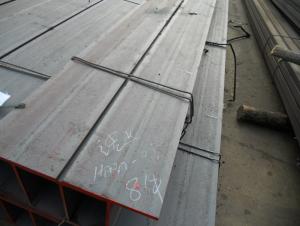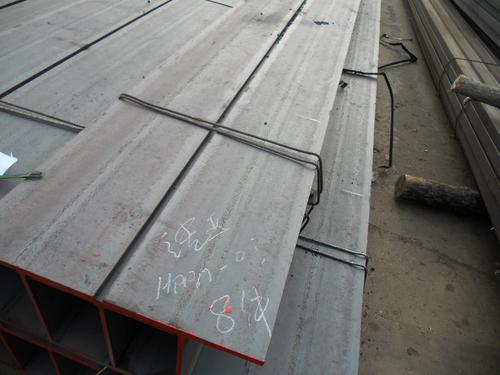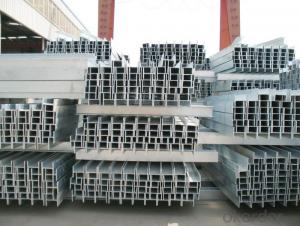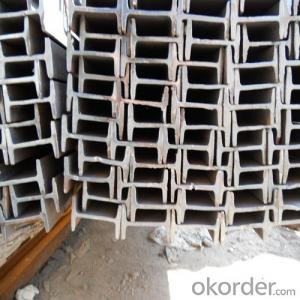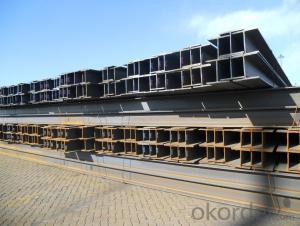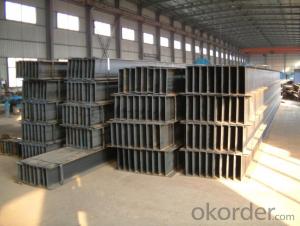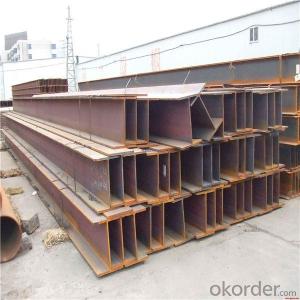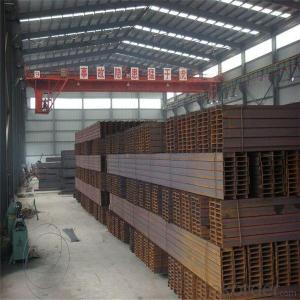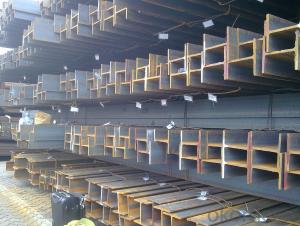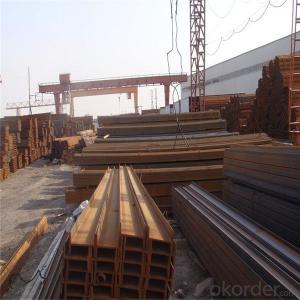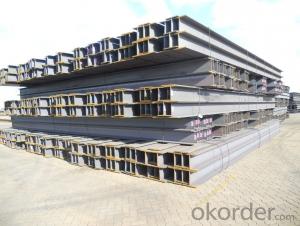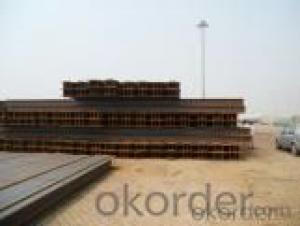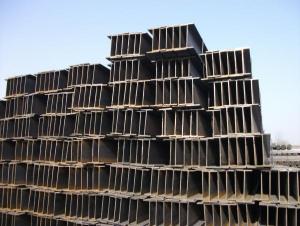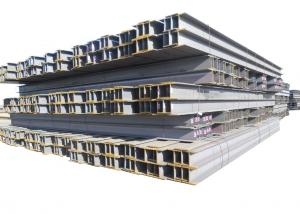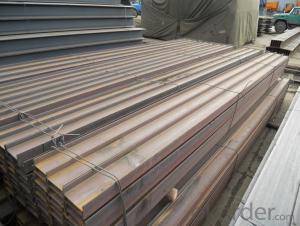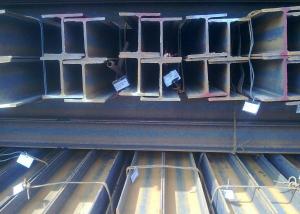GB Standard Steel H Beam 100mm-150mm with Good Quality
- Loading Port:
- China main port
- Payment Terms:
- TT or LC
- Min Order Qty:
- 40 m.t
- Supply Capability:
- 15000 m.t/month
OKorder Service Pledge
OKorder Financial Service
You Might Also Like
Specifications of GB Standard Steel H Beam 100mm-150mm with Good Quality For Sale:
1. Standard: GB Standard
2. Grade: Q235
3. Length: 12m
Size and mass:
| Size (mm) | Mass (Kg/m) | Size (mm) | Mass (Kg/m) |
| 100*100*6.0 | 16.9 | 150*75*5.0 | 14.0 |
| 125*125*6.5 | 23.6 | 148*100*6.0 | 20.7 |
Usage & Applications of GB Standard Steel H Beam 100mm-150mm with Good Quality For Sale:
Commercial building structure ;Pre-engineered buildings; Machinery support structure; Prefabricated structure; Medium scale bridges; Ship-building structure.etc.
Production flow of GB Standard Steel H Beam 100mm-150mm with Good Quality For Sale:
Material prepare (billet) —heat up—rough rolling—precision rolling—cooling—packing—storage and transportation
FAQ:
Q1: Why buy Materials & Equipment from OKorder.com?
A1: All products offered byOKorder.com are carefully selected from China's most reliable manufacturing enterprises. Through its ISO certifications, OKorder.com adheres to the highest standards and a commitment to supply chain safety and customer satisfaction.
Q2: How do we guarantee the quality of our products?
A2: We have established an advanced quality management system which conducts strict quality tests at every step, from raw materials to the final product. At the same time, we provide extensive follow-up service assurances as required.
Q3: How soon can we receive the product after purchase?
A3: Within three days of placing an order, we will arrange production. The shipping date is dependent upon the quatity, how many sizes you want and the plan of production, but is typically 1 month to 2 month days from the beginning of production.
Images of GB Standard Steel H Beam 100mm-150mm with Good Quality:
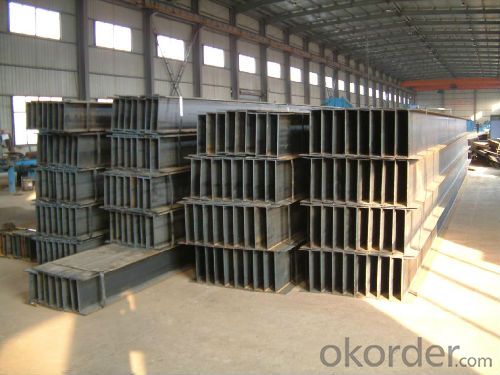
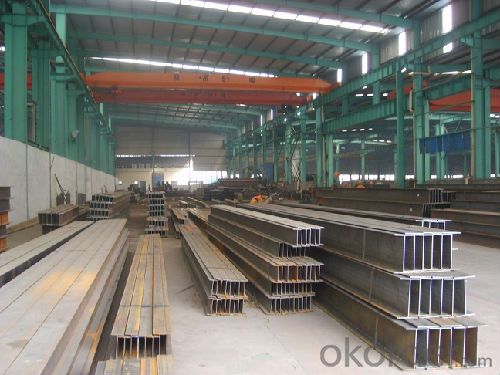
*If you would like to get our price, please inform us the size, standard/material and quantity. Thank you very much for your attention.
- Q: Can steel H-beams be used for cantilever structures?
- Certainly! Cantilever structures can indeed make use of steel H-beams. These structures are specifically designed to incorporate a projecting beam or member that is supported on just one end, while the other end remains free or unsupported. Steel H-beams are widely employed in the realm of construction due to their remarkable strength and ability to bear substantial loads. They are particularly well-suited for cantilever designs as they offer exceptional structural support, effectively minimizing deflection and ensuring overall stability. Nonetheless, it is imperative to take into account the specific requirements of the cantilever structure. In order to determine the appropriate size and strength of the H-beam necessary to support the desired load and span, it is highly recommended to seek guidance from a structural engineer.
- Q: What are the different load types that steel H-beams can withstand?
- Steel H-beams are designed to withstand various load types, making them highly versatile and suitable for a wide range of applications. The different load types that steel H-beams can withstand include: 1. Uniformly Distributed Load (UDL): Steel H-beams can bear a UDL, which is a load that is spread evenly across the entire length of the beam. This could be the weight of a floor or a roof, for example. 2. Point Load: Steel H-beams are also capable of withstanding point loads, which are concentrated forces applied at a specific point or area on the beam. Examples of point loads include the weight of a heavy equipment or machinery placed directly on the beam. 3. Torsional Load: Steel H-beams have the ability to resist torsional loads, which occur when a twisting force is applied to the beam. This is important in structures that may experience rotational forces, such as bridges or towers subjected to wind or seismic activity. 4. Lateral Load: Steel H-beams can withstand lateral loads, also known as horizontal loads, which are forces acting perpendicular to the axis of the beam. This is crucial in resisting the lateral forces caused by wind or earthquakes. 5. Axial Load: Steel H-beams are designed to resist axial loads, which are forces acting along the axis of the beam. These loads can be compressive (pushing the beam together) or tensile (pulling the beam apart). Axial loads are commonly encountered in columns or vertical members of a structure. 6. Shear Load: Steel H-beams can withstand shear loads, which occur when two forces act in opposite directions parallel to the cross-section of the beam. Shear forces can cause the beam to deform or fail if not properly accounted for in the design. It's important to note that the load capacity of steel H-beams varies depending on factors such as the size and shape of the beam, the type of steel used, and the specific design considerations of the structure. Therefore, it is crucial to consult engineering specifications and calculations to ensure that the H-beams are appropriately selected and applied for the specific load requirements of a given project.
- Q: Can steel H-beams be used in museum and art gallery construction?
- Museum and art gallery construction can incorporate steel H-beams for a variety of purposes. These beams possess strength, durability, and versatility, making them a popular choice in construction. They provide structural support and stability, making them suitable for large and intricate architectural designs found in museums and art galleries. Steel H-beams have multiple functions in museum and art gallery construction. They can serve as load-bearing elements, ensuring the building's stability and safety. Additionally, these beams can create spacious interiors and high ceilings, accommodating flexible exhibition layouts and the display of large artworks. Moreover, steel H-beams can contribute to the aesthetic appeal of the museum or art gallery. They can be exposed and integrated into the interior design, aligning with the artistic vision and enhancing the overall atmosphere and ambiance of the space. Furthermore, steel H-beams offer benefits in terms of cost-effectiveness and construction efficiency. They are lightweight, facilitating easier transportation and installation compared to other materials. Furthermore, steel is a recyclable material, aligning with sustainable construction practices. However, it is crucial to consider specific design requirements, load-bearing capacities, and the architectural vision when deciding to incorporate steel H-beams in museum and art gallery construction. Consulting with structural engineers and architects specialized in museum and art gallery construction is necessary to ensure the proper utilization of steel H-beams and the achievement of desired artistic and functional outcomes.
- Q: What are the common methods for joining steel H-beams in construction?
- Steel H-beams can be joined in construction using various methods. The most frequently employed technique is welding, where the beams are aligned and fused together through arc welding or gas welding. This creates a sturdy and long-lasting connection, ensuring the structural integrity of the beams. Another method involves using bolts to connect the steel H-beams. Holes are drilled into the flanges, and bolts are inserted through these holes and tightened with nuts. This allows for easy disassembly and reassembly if required. Riveting is an alternative method that involves using rivets to join the steel H-beams. Holes are drilled into the flanges and web, and rivets are inserted and secured through hammering or pressing. However, this method is time-consuming and has been largely replaced by welding and bolted connections. In some cases, adhesive bonding can be used to join steel H-beams. High-strength adhesives are applied to the surfaces of the beams, and they are then pressed together. Although not as commonly used as welding or bolted connections, adhesive bonding can be a viable option in certain situations. Overall, welding and bolted connections are the predominant methods for joining steel H-beams in construction. These techniques provide robust and reliable connections, ensuring the stability and integrity of the structure.
- Q: What are the different methods of joining Steel H-Beams together?
- There exists a variety of techniques for connecting steel H-beams together, depending on the project's specific circumstances and requirements. Welding, bolting, and riveting are among the most commonly employed methods. 1. Welding: Considered the most popular and extensively used technique, welding involves melting the adjacent surfaces of the beams and allowing them to cool and solidify, effectively fusing them together. The choice of welding technique, such as arc welding, gas welding, or laser welding, depends on the steel's thickness and type. 2. Bolting: Another prevalent method involves using bolts and nuts to secure the steel H-beams together. Bolting is often preferred when disassembling or reassembling the structure is necessary. This method provides a strong and reliable connection, allowing for easy adjustment or replacement of beams when required. 3. Riveting: A traditional technique, riveting, involves using metal rivets to join the steel H-beams together. It requires drilling holes in the flanges of the beams and securing the rivets through them. Riveting offers a robust and durable connection, but it can be time-consuming and necessitates skilled labor. 4. Adhesive bonding: Adhesive bonding, although less commonly used, employs high-strength adhesives to bond the surfaces of the steel H-beams. This method is often utilized in applications where welding or bolting may not be feasible or desirable, such as in certain architectural or aesthetic projects. 5. Hybrid methods: In some instances, a combination of different joining techniques may be employed to achieve the desired connection strength and structural integrity. For example, welding and bolting can be combined to provide additional reinforcement and stability. It is crucial to note that the selection of the joining method depends on factors such as load-bearing requirements, structural design, accessibility, and available skills and equipment. Consulting with a structural engineer or a professional in the field is advisable to determine the most suitable method for a specific project.
- Q: Are steel H-beams suitable for structures with curved elements?
- Structures with curved elements are not typically compatible with steel H-beams. H-beams are specifically engineered for straight or inflexible structures, such as beams and columns, in order to provide optimal strength and stability. Due to their straight and rigid composition, it is challenging to bend or curve H-beams without compromising their structural integrity. For structures that incorporate curved elements, it is advisable to utilize alternative types of structural members, such as curved steel beams or trusses, which are specifically designed and manufactured to accommodate curved elements while maintaining their structural strength. Implementing steel H-beams in structures with curved elements can result in various challenges and potential issues, including excessive bending stress, deformation, and structural instability. Therefore, consulting with a structural engineer or an expert in steel fabrication is crucial in order to determine the most appropriate structural members for such structures.
- Q: In steel structures, what is the meaning of the "" between the two members of the H steel brace 2L 180*12,10?
- Specific means: double angle, angle type: L180*180*12, because the angle is equal angles, so it can be omitted in: L180*12. where: 180 refers to the angle of the width, 12 refers to the average thickness of.L boundary angle is the angle of the code before the.L 2 is Larry.
- Q: Can steel H-beams be used in sports complex or stadium construction?
- Yes, steel H-beams can be used in sports complex or stadium construction. Steel H-beams are commonly used in large-scale projects due to their high strength-to-weight ratio, versatility, and ability to withstand heavy loads. They provide structural support and stability, making them an ideal choice for constructing sports facilities such as stadiums and sports complexes.
- Q: What are the disadvantages of using steel H-beams?
- There are several disadvantages of using steel H-beams in construction projects. Firstly, steel H-beams are relatively heavy compared to other building materials. This can make transportation and installation more challenging, especially in projects that require large quantities of beams. The weight of steel H-beams also adds to the overall load-bearing capacity of the structure, which may require additional reinforcement or support. Secondly, steel H-beams are prone to corrosion if not properly protected. Exposure to moisture and harsh weather conditions can cause rust and structural deterioration over time. To prevent corrosion, additional measures such as galvanization or regular maintenance are necessary, adding to the overall cost and effort. Moreover, steel H-beams are not as environmentally friendly as some alternative materials. The production of steel involves high energy consumption and emits significant amounts of carbon dioxide, contributing to climate change. Additionally, steel is not a renewable resource and requires mining and extraction, which can have negative impacts on the environment. Lastly, steel H-beams have limited design flexibility compared to some other materials. The standard shape and size of H-beams may not always be suitable for certain architectural or structural designs. This limitation can restrict the creativity and customization options for architects and engineers, potentially compromising the overall aesthetics or functionality of the project. Overall, while steel H-beams have many advantages such as high strength and durability, it is important to consider these disadvantages in terms of weight, corrosion, environmental impact, and design limitations when deciding whether to use them in a construction project.
- Q: Are steel H-beams suitable for seismic zones?
- Steel H-beams are indeed suitable for seismic zones. Due to its high durability and ductility, steel has been widely utilized in areas prone to seismic activity. Specifically designed to provide structural support and stability, H-beams, also referred to as I-beams, are well-suited for seismic zones. The distinctive shape of H-beams, featuring a wider flange and narrower web, enables them to evenly and efficiently distribute loads. This design enhances their load-bearing capacity and resistance to bending moments, making them ideal for seismic conditions. Additionally, the cross-sectional shape of H-beams provides excellent resistance against lateral forces commonly experienced during seismic events. Moreover, steel H-beams can be fabricated to meet specific seismic design requirements. They can be reinforced with additional steel plates or braces to enhance their strength and stiffness. These beams can also be designed to offer flexibility and ductility, crucial in absorbing and dissipating energy during earthquakes. Furthermore, steel H-beams offer numerous advantages in seismic zones. They are non-combustible, minimizing the risk of fire-related incidents. Additionally, steel beams are lightweight compared to other construction materials, making them easier to transport and install in regions prone to earthquakes. Furthermore, steel is a recyclable material, contributing to sustainable construction practices. However, it is important to consider various factors, such as design considerations, foundation conditions, and local building codes, to determine the suitability of steel H-beams in seismic zones. Consulting with structural engineers and adhering to seismic design guidelines is essential to ensure the safe and effective utilization of steel H-beams in seismic regions.
Send your message to us
GB Standard Steel H Beam 100mm-150mm with Good Quality
- Loading Port:
- China main port
- Payment Terms:
- TT or LC
- Min Order Qty:
- 40 m.t
- Supply Capability:
- 15000 m.t/month
OKorder Service Pledge
OKorder Financial Service
Similar products
Hot products
Hot Searches
Related keywords
